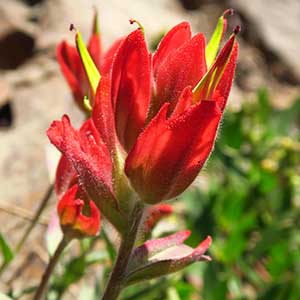Castilleja glandulifera
Castilleja elmeri
gland Indian paintbrush, glandular paintbrush, sticky paintbrush
Elmer's Indian paintbrush, Elmer's paintbrush, Wenatchee Indian paintbrush, Wenatchee paintbrush
few to many, erect or ascending, sometimes decumbent, unbranched or often branched proximally, hairs spreading, medium length and long, soft, mixed with more abundant stipitate-glandular ones.
solitary or few to many, erect to ascending, sometimes slightly curved at base, unbranched, rarely branched, hairs moderately dense, spreading, medium length, soft, mixed with shorter eglandular and stipitate-glandular ones, at least on distal 1/2 of stem.
green, linear-lanceolate to sometimes narrowly oblong or narrowly oblanceolate, 0.7–3.7 cm, not fleshy, margins wavy, involute, 0(–5)-lobed, apex acute;
lateral lobes ascending to erect, narrowly lanceolate to narrowly oblong, usually narrower than center lobe, apex acute.
green, rarely purple-tinged, linear-lanceolate, sometimes linear or lanceolate, 1.3–6.5 cm, not fleshy, margins plane, flat or involute, entire, apex acute.
2.5–10 × 2–5 cm;
bracts proximally pale green to pale yellow, distally yellow, whitish, pink, dull red, or purple on apices (sometimes gradually differentiated from proximal coloration), lanceolate, broadly lanceolate, or oblong, 3–5(–7)-lobed, sometimes with secondary lobes;
lobes ascending to spreading, linear, sometimes rounded, medium length or distal short, arising near mid length, apex acute to rarely obtuse.
2.5–9 × 1.5–3 cm;
bracts red, crimson, scarlet, pink, magenta, red-orange, burnt orange, orange, pale yellow, or whitish throughout, or proximally greenish, distally as stated above, oblong, narrowly obovate, elliptic-oblong, or narrowly ovate, 0(–5)-lobed, rarely with 1 or 2 pairs of short, usually distal lobes;
lobes ascending, lanceolate, very short, arising from distal edge, apex rounded to obtuse.
0 mm.
straight or slightly curved, (20–)22–30 mm;
tube 15 mm;
abaxial lip usually hidden or just visible in abaxial calyx notch, not exserted/longer than calyx, beak exserted;
beak straight or slightly curved, adaxially green, 8–11(–12) mm;
abaxial lip deep green to yellow, reduced, slightly pouched, 1–2.5 mm, to 20% as long as beak;
teeth incurved, green to yellow, 0.5–1 mm.
straight, 20–33 mm;
tubes 13–18 mm;
beak, and sometimes abaxial lip, partially to fully exserted;
beak adaxially green to yellowish, 8–15 mm;
abaxial lip incurved, green, thickened, 2–3 mm, 20–33% as long as beak;
teeth ascending or incurved, green, 0.5–1 mm.
proximally green or pale, distally colored as bracts, 17–21(–23) mm;
abaxial and adaxial clefts 4–8 mm, 33–50% of calyx length, deeper than laterals, lateral 2–6 mm, 15–33% of calyx length;
lobes linear, narrowly lanceolate, or narrowly triangular to oblong, apex acute.
proximally green to pale green, distally colored as bracts, 15–25 mm;
abaxial and adaxial clefts 5–14 mm, 33–50% of calyx length, deeper than laterals, lateral 1–4 mm, 6–20% of calyx length;
lobes lanceolate to narrowly triangular, apex rounded to obtuse.
= 48.
Castilleja glandulifera
Castilleja elmeri
Castilleja glandulifera is endemic to the upper elevations of the Blue and Strawberry mountains of northeastern Oregon, as well as a few adjacent minor ranges. It is related to C. applegatei and C. viscidula, which are the source of reports of C. glandulifera in the Wallowa Mountains and on Steens Mountain. Inflorescences of C. glandulifera are usually white to pale yellow, but in the area around Marble Creek Pass in Baker County, they are multicolored, with a variety of reddish shades mixed in among the yellowish plants. Castilleja glandulifera and C. viscidula share a glandular pubescence, divided leaves, and usually yellowish inflorescences. Castilleja glandulifera is distinguished from C. viscidula by its taller stature, longer corolla beak, and more deeply divided leaves and bracts with linear to linear-lanceolate lobes. Castilleja glandulifera differs from C. applegatei by its unusual leaves and bracts as well as by its habitat and narrower and somewhat shorter corolla beak.
(Discussion copyrighted by Flora of North America; reprinted with permission.)
The bracts and inflorescences of Castilleja elmeri can be red, crimson, scarlet, pink, magenta, red-orange, burnt orange, orange, pale yellow, or whitish. While the coloration is highly variable between local populations, it is usually uniform and consistent within them. It is found primarily in the Wenatchee Mountains of Washington, where it is often on serpentine, but it ranges northward in the Cascades into extreme southern British Columbia, apparently on non-serpentine substrates. Hybrids with C. miniata var. miniata, C. parviflora var. albida, and C. thompsonii have been found in the eastern Cascades of Washington, and a similar hybrid swarm with C. thompsonii is reported from southern British Columbia.
(Discussion copyrighted by Flora of North America; reprinted with permission.)


